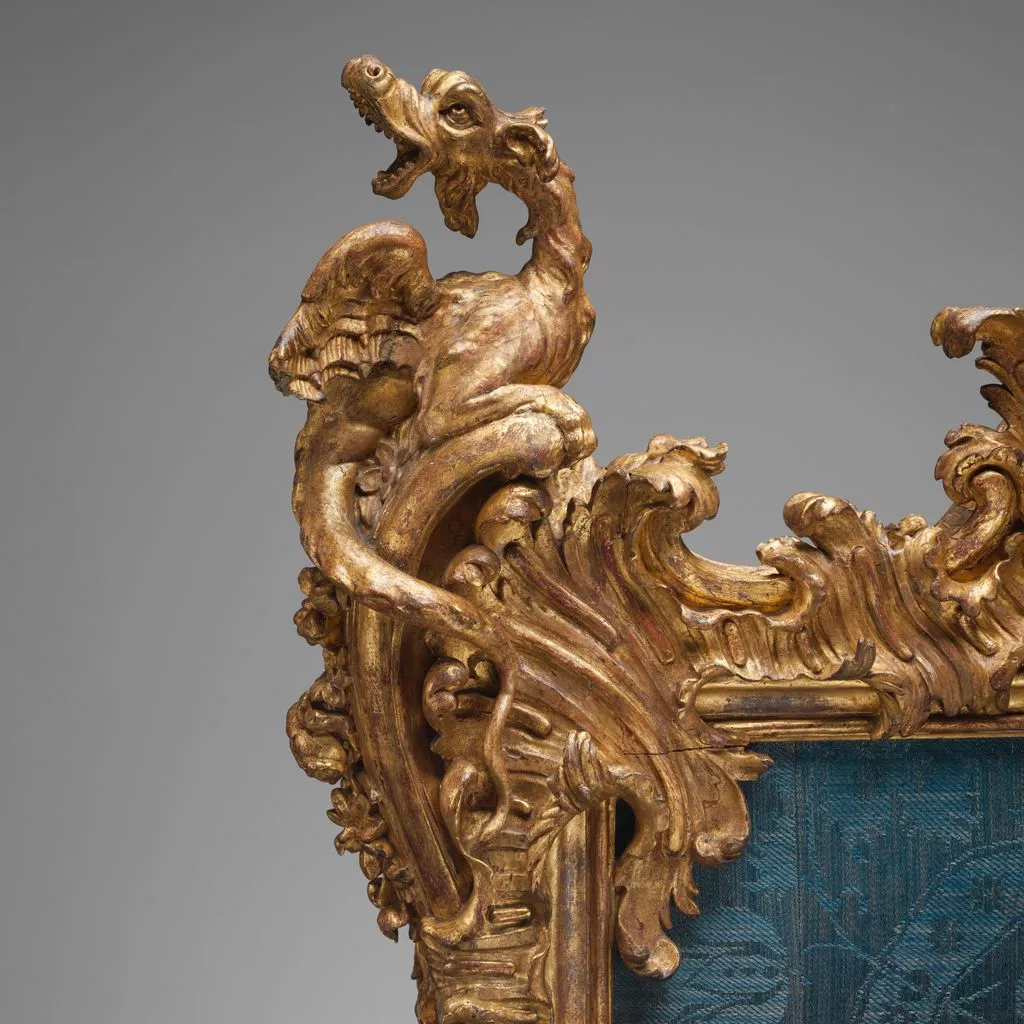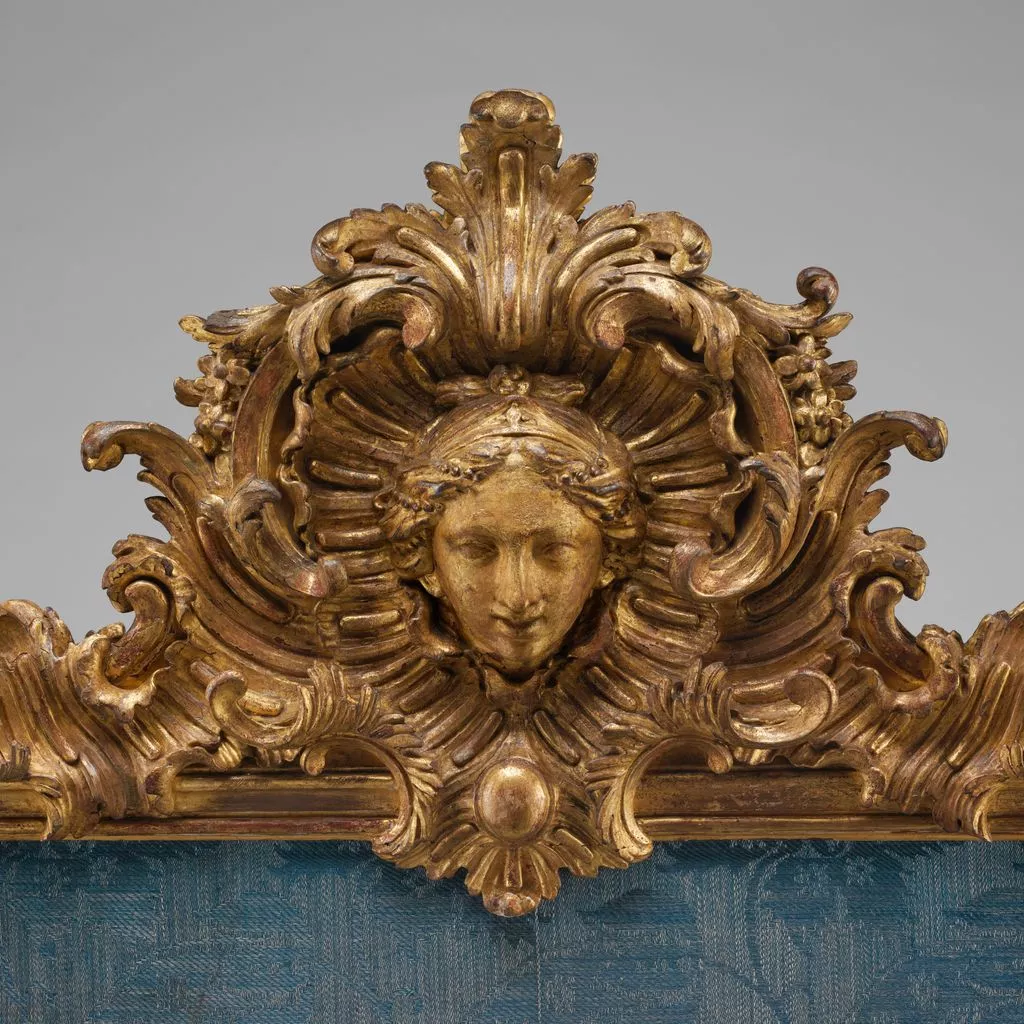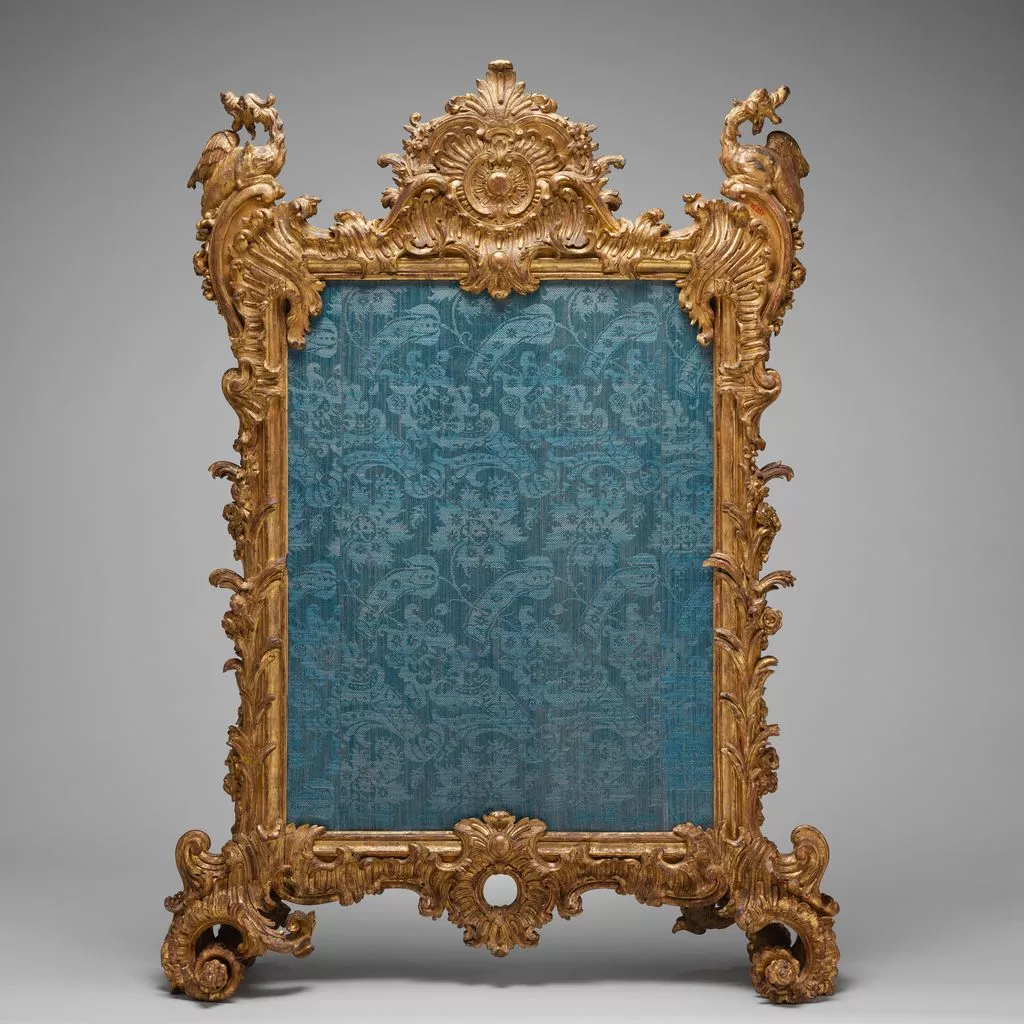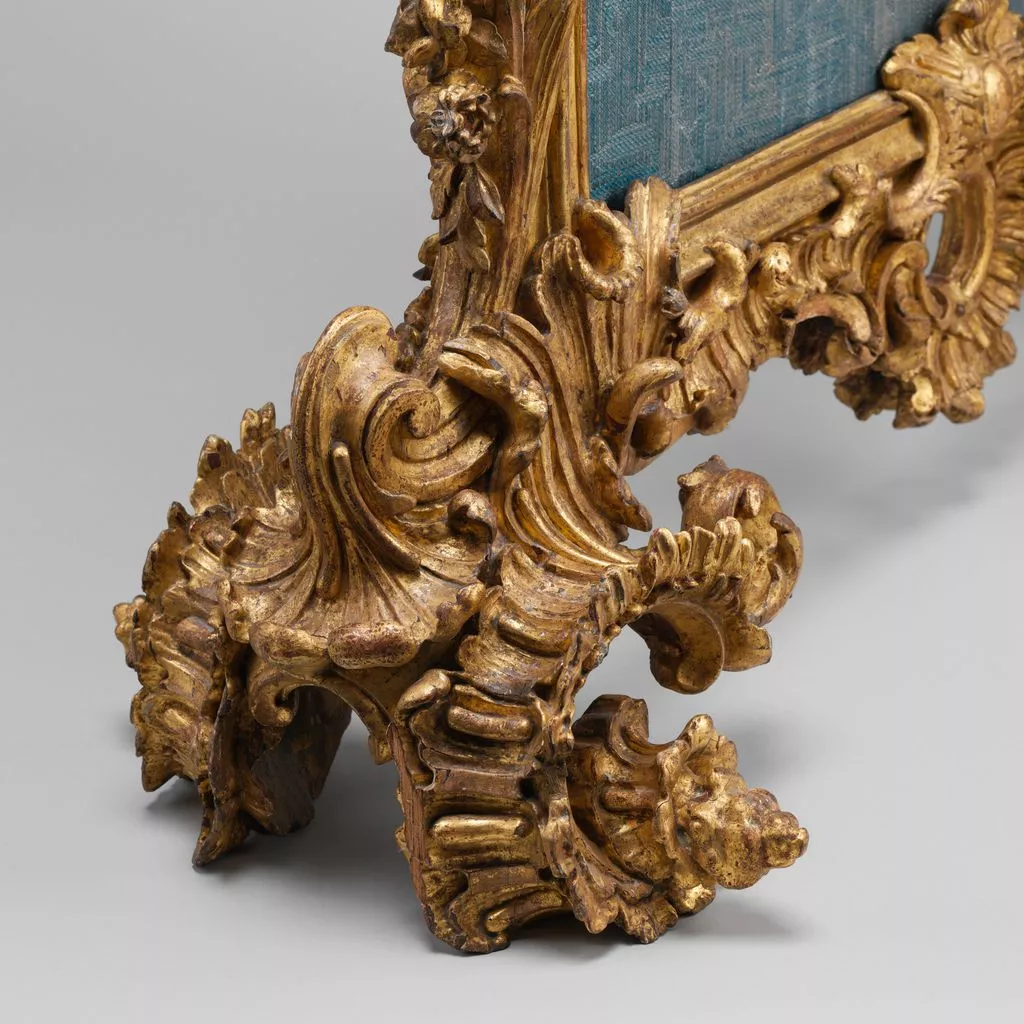Description
Fire screens have been used since the Middle Ages to shield those standing or seated near a fireplace from the excessive heat of the open flames and from flying sparks. Toward the end of the seventeenth century, screens of rectangular shape with a large central panel of colorful fabric or other boldly contrasting material were developed to conceal the dark opening beneath the mantel that otherwise would interrupt the ornamental dado and paneled decoration of the room.[1] The materials used for the frame of these screens ranged from wrought iron or copper to carved wood or even silver, and the panel was often decorated with scenes from the forge of Vulcan, the Roman god of fire.[2] Especially vulnerable to changing fashions and fire damage, exuberantly carved screens such as the present example have only rarely survived. The purpose of the Museum's screen is suggested by its decoration. At the top, two snake-dragons that seem to breathe fire from their gaping jaws flank the idealized head of a woman in a shell-and-acanthus cartouche. By turning their heads away from the goddesslike image they protect her complexion from damaging heat, a conceit that conjures the ideal of feminine beauty at the time.Long thought to be of French origin,[3] this screen in fact represents virtuoso Franconian Rococo carving at its sculptural best.[4] The expressive design and skillful carving suggest that it was one of several screens ordered for the lavishly furnished palace, or Residenz, in Würzburg, the cultural capital of Franconia, by Friedrich Karl von Schönborn (1674–1746). As prince-bishop of Bamberg and Würzburg, this noble prelate ruled as the spiritual head of the regional Catholic Church and as an independent prince of the Holy Roman Empire, who—in theory—held the emperor as his feudal lord. The office of prince-bishop, a political unicum of the Holy Roman Empire and some neighboring areas, was said to be based on the biblical model of Melchizedek, who is described as high priest and king in the book of Genesis.[5] Since the prince-bishops had to defend the various interests of both church and state, they needed to amass considerable political power and wield it skillfully to allay the tensions that inevitably occurred. Moreover, it was in the interest of the bishops to use their office to increase the influence of their family and to elevate it within the feudal system. None of them understood better the importance of using the visual arts to impress friends and enemies alike with the magnitude of their worldly power than Friedrich Karl von Schönborn. During his tenure, the palace at Würzburg became one of the most magnificent and splendidly appointed residences of the late Baroque period. Friedrich Karl's architect Balthasar Neumann (1687–1753) hired only the best artisans to decorate it, and Ferdinand Hundt was one of them.Hundt settled in Würzburg in 1735 and began work the following year in the west wing under the supervision of Neumann, who called him "the best of all ornamental carvers."[6] Closely related to the present example is Hundt's fire screen of 1736 in the Residenz, with a crest incorporating the coat of arms of Friedrich Karl. The exuberantly formed shell feet of that screen are also conceived as scrolls with a C-shaped volute emerging on either side.[7] Ornamental compositions with surging rocaille formations, cartouches, and dragon heads characterize Hundt's designs for the carved wood paneling of the audience chamber (ca. 1742).[8] A group of candlestands carved about 1744 by Hundt also relate to the Museum's fire screen in their details, although their outline is unusually restrained. Later, Hundt created fully developed snake-dragons and shell-and-acanthus cartouches for the palace at Bruchsal, built by Cardinal Damian Hugo von Schönborn (1676–1743), prince-bishop of Speyer and a brother of the Würzburg palace's patron.[9] The blue fabric now stretched on a removable panel set within the screen probably replaced a very elaborate decorative panel of silk or lamé embroidered with precious silvered or gilded metal threads.[10][Wolfram Koeppe 2006]Footnotes:[1] Henry Havard. Dictionnaire de l'ameublement et de la décoration depuis le XVIIIe siècle jusqu'à nos jours. 4 vols. Paris, 1887–90, vol. 2, cols. 311-27; and Nicole de Reyniès. Le mobilier domestique: Vocabulaire typologique. 2 vols. Principes d'analyse scientifique 5. Inventaire général des monuments et des richesses artistiques de la France. Paris, 1987, vol. 2, pp. 768-74.[2] Reinhold Baumstark and Helmut Seling, eds. Silber und Gold: Augsburger Goldschmiedekunst für die Höfe Europas. 2 vols. Exh. cat., Bayerisches Nationalmuseum. Munich, 1994, vol. 2, pp. 490-93, no. 140 (entry by Gisela Haase).[3] Preston Remington. "A French XVIII Century Fire Screen." Bulletin of The Metropolitan Museum of Art 30 (May 1935), pp. 109–11.[4] Nevertheless, the crest motif with the central cartouche and dragons is inspired by French designs, as the similar carved back of an earlier daybed at the Museum documents (acc. no. 22.144); Meyric R. Rogers. "An Eighteenth–Century French Day-Bed." Bulletin of The Metropolitan Museum of Art 17 (December 1922), p. 260.[5] Genesis 14:18-24.[6] Heinrich Kreisel. Die Kunst des deutschen Möbels: Möbel und Vertäfelungen des deutschn Sprachraums von den Anfängen bis zum Jugendstil. Vol. 2, Spätbarock und Rokoko. 2nd ed. Rev. by Georg Himmelheber. Munich, 1983, p. 194; and John Fleming and Hugh Honour. The Penguin Dictionary of Decorative Arts. New ed. London and New York, 1989, p. 406.[7] Heinrich Kreisel. Die Kunst des deutschen Möbels: Möbel und Vertäfelungen des deutschn Sprachraums von den Anfängen bis zum Jugendstil. Vol. 2, Spätbarock und Rokoko. 2nd ed. Rev. by Georg Himmelheber. Munich, 1983, fig. 521.[8] Ibid., fig. 516.[9] Ibid., figs. 523, 569.[10] Compare Heinrich Kreisel. Die Kunst des deutschen Möbels: Möbel und Vertäfelungen des deutschn Sprachraums von den Anfängen bis zum Jugendstil. Vol. 2, Spätbarock und Rokoko. 2nd ed. Rev. by Georg Himmelheber. Munich, 1983, fig. 598; Brigitte Langer and Alexander Herzog von Württemberg. Die deutschen Möbel des 16. bis 18. Jahrhunderts. Vol. 2 of Die Möbel der Residenz München, ed. Gerhard Hojer and Hans Ottomeyer. Kataloge der Kunstsammlungen/Bayrische Verwaltung der Staatlichen Schlösser, Gärten und Seen. Munich and New York, 1996, p. 127, no. 21 (entry by Alexander, Herzog von Würrtemberg); Brigitte Langer. Die Möbel der Schlösser Nymphenburg and Schleissheim. Munich, London, and New York, 2000, p. 179, no. 60; and Brigitte Langer, ed. Pracht und Zeremoniell: Die Möbel der Residenz München. Exh. cat., Residenz, Munich. Organized by the Bayerische Verwaltung der Staatlichen Schlösser, Gärten und Seen. Munich, 2002, p. 229, no. 73 (entry by Edgar Bierende).
















